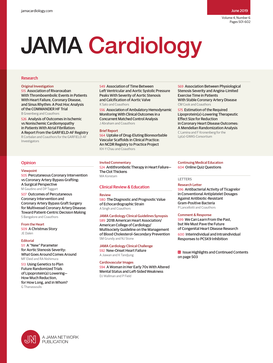心肌病中LMNA变异的位置和临床结果。
IF 14.1
1区 医学
Q1 CARDIAC & CARDIOVASCULAR SYSTEMS
引用次数: 0
摘要
先前的研究表明,非错义(即截断)变异导致LMNA心肌病的患者与错义变异患者相比,心律失常的结果更差。然而,错义和截断变异的空间分布对临床结果的影响仍然知之甚少。目的探讨错义和截断型LMNA变异的空间分布与心脏预后的关系。设计、环境和参与者:这项多中心、回顾性、观察性队列研究使用了来自国际注册中心(2013年1月至今)和来自三级心肌病中心(2000年1月至2017年6月)的数据。可能具有致病性/致病性LMNA变异且既往无恶性室性心律失常(VA)的患者符合纳入条件。数据分析时间为2022年3月至2025年3月。主要结局和测量方法:发生心脏骤停时间的主要结局定义为心源性猝死、适当的植入式心律转复除颤器治疗或其他血流动力学不稳定的心脏骤停的表现。晚期心力衰竭的次要复合结局定义为非心源性猝死、植入左心室辅助装置或心脏移植。结果按变异类型(错义或截断)、受影响的转录本位置(头、杆或尾)和LMNA基因上的位置进行分层。结果共纳入718例患者,其中平均(SD)年龄41.1岁(14.3岁),女性381例(53.1%),平均(SD)基线左室射血分数55.8%(13.3%)。在4.2年的中位随访中,223名患者出现了恶性VA的主要结局,109名患者出现了晚期心力衰竭的次要结局。截断变异的患者患VA的风险较高(风险比[HR], 1.72;95% ci, 1.19-2.48;P = 0.004),但晚期心力衰竭无差异(HR, 0.94;95% ci, 0.64-1.40;P = .77)。当根据LMNA基因位置或转录物位置对截断变异进行分层时,主要和次要结果没有显著差异。相反,在多变量分析中,影响LMNA尾部结构域的错义变异(HR, 0.35;95% ci, 0.16-0.78;P = 0.02),位于外显子7 ~ 12 (HR, 0.39;95% ci, 0.17-0.89;结论和相关性在这项回顾性队列研究中,截断的LMNA变异与较差的心律失常结果相关,与变异位置无关,而影响尾结构域并位于外显子7至12的错义变异具有较好的心律失常和心力衰竭结果。了解这些差异背后的机制可能会对未来的治疗产生影响。本文章由计算机程序翻译,如有差异,请以英文原文为准。
Location of LMNA Variants and Clinical Outcomes in Cardiomyopathy.
Importance
Prior studies have suggested that patients with nonmissense (ie, truncating) variants causing LMNA cardiomyopathy have worse arrhythmic outcomes compared to those with missense variants. However, the effect of the spatial distribution of missense and truncating variants on clinical outcomes remains poorly understood.
Objective
To determine the association of the spatial distribution of missense and truncating LMNA variants with cardiac outcomes.
Design, Setting, and Participants
This multicenter, retrospective, observational cohort study used data from an international registry (from January 2013 on) and data derived from tertiary cardiomyopathy centers (January 2000 and June 2017). Patients with likely pathogenic/pathogenic LMNA variants and no prior malignant ventricular arrhythmia (VA) were eligible for inclusion. Data analysis was completed from March 2022 to March 2025.
Main Outcomes and Measures
The primary outcome of time to VA was defined as sudden cardiac death, appropriate implantable cardioverter-defibrillator therapy, or other manifestations of hemodynamically unstable VA. The secondary composite outcome of advanced heart failure was defined as nonsudden cardiac death, implantation of a left ventricular assist device, or cardiac transplant. Outcomes were stratified by type of variant (missense or truncating), affected transcript position (head, rod, or tail), and location on the LMNA gene.
Results
A total of 718 patients were included, among whom mean (SD) age was 41.1 (14.3) years, 381 patients (53.1%) were female, and mean (SD) baseline left ventricular ejection fraction was 55.8% (13.3%). Over a median follow-up of 4.2 years, 223 patients experienced the primary outcome of malignant VA and 109 experienced the secondary outcome of advanced heart failure. Patients with truncating variants had a higher risk of VA (hazard ratio [HR], 1.72; 95% CI, 1.19-2.48; P = .004) but no difference in advanced heart failure (HR, 0.94; 95% CI, 0.64-1.40; P = .77) compared with patients with missense variants. There were no significant differences in the primary and secondary outcomes when stratifying truncating variants by location on the LMNA gene or transcript position. In contrast, on multivariable analysis, missense variants affecting the tail domain of LMNA (HR, 0.35; 95% CI, 0.16-0.78; P = .02) and located in exons 7 through 12 (HR, 0.39; 95% CI, 0.17-0.89; P = .035) were associated with a significantly lower risk of the primary outcome of malignant VA.
Conclusions and Relevance
In this retrospective cohort study, truncating LMNA variants were associated with worse arrhythmic outcomes independent of variant position, whereas missense variants affecting the tail domain and located in exons 7 through 12 had better arrhythmic and heart failure outcomes. Understanding the mechanisms underlying these differences may have future therapeutic implications.
求助全文
通过发布文献求助,成功后即可免费获取论文全文。
去求助
来源期刊

JAMA cardiology
Medicine-Cardiology and Cardiovascular Medicine
CiteScore
45.80
自引率
1.70%
发文量
264
期刊介绍:
JAMA Cardiology, an international peer-reviewed journal, serves as the premier publication for clinical investigators, clinicians, and trainees in cardiovascular medicine worldwide. As a member of the JAMA Network, it aligns with a consortium of peer-reviewed general medical and specialty publications.
Published online weekly, every Wednesday, and in 12 print/online issues annually, JAMA Cardiology attracts over 4.3 million annual article views and downloads. Research articles become freely accessible online 12 months post-publication without any author fees. Moreover, the online version is readily accessible to institutions in developing countries through the World Health Organization's HINARI program.
Positioned at the intersection of clinical investigation, actionable clinical science, and clinical practice, JAMA Cardiology prioritizes traditional and evolving cardiovascular medicine, alongside evidence-based health policy. It places particular emphasis on health equity, especially when grounded in original science, as a top editorial priority.
 求助内容:
求助内容: 应助结果提醒方式:
应助结果提醒方式:


